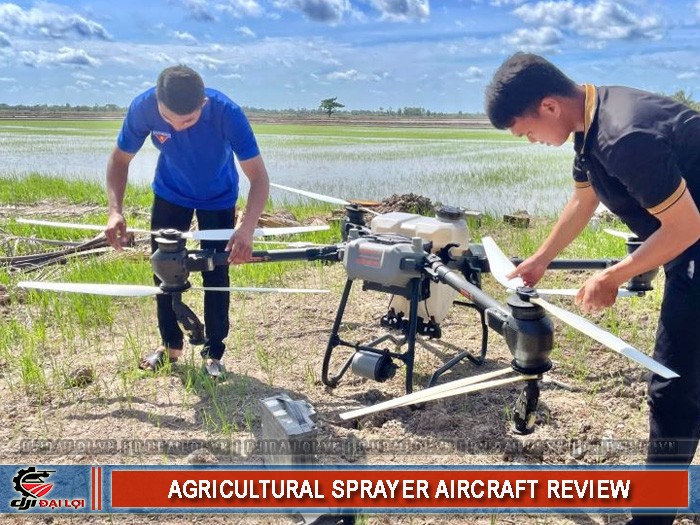
Short-term rice (90–100 days growth cycle) - often grown in lowland fields - benefits from smaller, lightweight drones with flexible maneuverability and fuel efficiency.
Long-term rice, with taller stalks and denser canopies, requires higher spray pressure, wider coverage, and larger tank capacity to ensure deep penetration of chemicals.
Understanding the growth traits of each rice variety helps select the right drone, avoiding over- or under-spraying that leads to waste or reduced pest control effectiveness.
Flooded fields have reflective water surfaces and high humidity, requiring drones with dual radar systems to maintain accurate spraying height.
Dry or terraced fields, on the other hand, demand high-precision GPS mapping and automatic pressure adjustment to ensure consistent coverage.
Selecting the appropriate rice-spraying drone based on terrain ensures even distribution, reduced solution use, and improved yield across the season.
Dense seeding creates tight canopies, requiring ultra-fine mist nozzles to prevent over-wetting and leaf burn. Sparse fields can use low-pressure drones to save energy.
Advanced models like DJI Agras T40 and T50 feature canopy sensors that automatically adjust spray volume to suit crop density.
Tank capacity (15–40L) directly impacts productivity. For areas over 3 hectares, large-capacity drones reduce refueling frequency. For example, the DJI T50 can spray up to 16 hectares per hour, quadrupling manual productivity and achieving over 98% spray coverage.
Optimal drone speed (6–8 m/s) ensures uniform droplet coverage and stability against wind drift. RTK GPS and terrain-following sensors enable centimeter-level precision - crucial for curved or uneven rice fields. Accurate flight control saves both chemicals and battery life.
Electric drones are quieter and eco-friendly but have shorter flight durations. Gas-powered drones can fly continuously for 1–2 hours, ideal for large farms. Farmers should balance fuel cost vs productivity when choosing between the two.
The high humidity of rice fields can damage unprotected components. Drones rated IP67 or higher - like DJI T50 and XAG P100 Pro - feature corrosion-resistant carbon shells and sealed electronics, allowing safe operation even in temporary waterlogging.
|
Model |
Tank Capacity |
Spraying Output |
Key Advantages |
|---|---|---|---|
|
DJI T30 |
30L |
8–10 ha/hour |
Compact, energy-efficient |
|
DJI T40 |
40L |
12–14 ha/hour |
Dual radar, multi-directional sensors |
|
DJI T50 |
50L |
16–18 ha/hour |
High performance, 3D precision mapping |
Farmers can choose the right model based on field size and rice type to balance investment cost and efficiency.
Electric models are ideal for households - easy to maintain and operate quietly. Gasoline drones are better for large cooperatives due to extended flight time and stronger lift. Hybrid drones, combining both power sources, are emerging as a cost-efficient trend that ensures continuous spraying productivity.
Modern drones achieve 95–98% coverage while reducing pesticide use by 30% compared to manual methods. Models with adjustable droplet-size control allow deeper penetration, crucial for tall or dense rice varieties.
Use lightweight drones like DJI T20P or T25, which are easy to handle and cost-efficient. Dividing the field into flight zones helps optimize chemical use and battery life.
Farms over 5 hectares should use 40–50L drones with dual-nozzle systems for higher flow rates. Models such as DJI T50 or XAG V40 support centralized management, allowing multiple drones to operate simultaneously.
A 3-person team can manage 2 drones to spray over 30 hectares per day. The total operating cost is about 40% of manual labor, making rice-spraying drones an economically viable solution for large-scale rice regions.
During tillering, lower the spray flow to avoid stem breakage. During heading or flowering, increase pressure for better penetration. This optimization can reduce pesticide consumption by up to 20%.
Only spray when wind speed is below 4 m/s. In stronger winds, lower the flight altitude and reduce flight speed. Modern drones with wind-compensation radar can automatically adjust nozzle angles to ensure even coverage.
After each crop, clean nozzles, check motors and batteries. Every 6 months, replace lubricants and sensors. Regular maintenance keeps the rice-spraying drone stable, prevents power loss, and lowers long-term repair costs.
Artificial intelligence enables drones to automatically detect pest-affected zones and adjust spray volumes dynamically - cutting pesticide use by up to 25% without reducing effectiveness.
Dual radar systems measure multi-directional distances, ensuring accurate spraying even on terraced fields. 3D terrain maps let drones adjust altitude automatically, minimizing over-spraying or coverage gaps.
By 2025, synchronized drone fleets will be managed through cloud platforms. Farmers will remotely control up to 10 drones, schedule spraying tasks, monitor maintenance, and track real-time performance.
Selection should be based on farm size, rice variety, terrain, and climate. Core elements - tank capacity, GPS accuracy, radar technology, and durability - determine long-term spraying efficiency.
While high-quality drones have a higher upfront cost, they significantly reduce labor and pesticide expenses over time. Keeping up with technology and performing regular maintenance ensures farmers maximize benefits over multiple seasons.
Choosing the right rice-spraying drone not only saves labor and materials but also guarantees consistent yields season after season. Understanding crop characteristics, field conditions, and operational scale is key to sustainable agricultural investment.
No, when used correctly with proper dosages and suitable chemicals. Drones minimize chemical runoff and water contamination compared to manual spraying.
Early morning or late afternoon, when wind speeds are below 4 m/s. These periods ensure better stability, droplet adhesion, and minimal evaporation.
Yes. Many cooperatives and agribusinesses now offer drone-spraying services, ideal for small farms wanting to save on initial investment costs.
Depending on the model, batteries typically last 15–25 minutes, covering 1–2 hectares per charge. Having 2–3 spare batteries ensures continuous operation.
Yes. Operators should complete basic training on GPS control, spraying height, and flight safety. A 1–2 day course is usually enough for farmers to operate efficiently and safely.